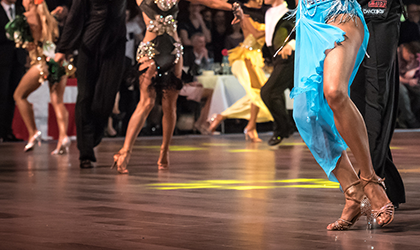
I don’t watch Strictly Come Dancing, the BBC’s hit reality dance show. I have seen an episode or two in the past, usually at family dinners when one or both of my grandmothers insisted we watch it. But despite my general lack of interest, I was delighted to see that Alexandra and Gorka, and Debbie and Giovanni had made it through to the final of series 15, just as Susan Connolly said they would.
Connolly is a PhD student at the MRC Biostatistics Unit, working on the design of case cohort studies. She is also a statistical ambassador of the Royal Statistical Society, which is how she came to be involved in this Strictly analysis. Like me, she’s no die-hard fan of the show. In fact, she was unaware that her favoured semi-finalists had made it through to the last stage of the competition until I told her the news. Still, Connolly knows a thing or two about the competition, having analysed 14 series’ worth of data.
She volunteered to help at the request of the BBC Reality Check team, who were interested to find out whether all this information could help them predict the winner. Using figures compiled by the Ultimate Strictly fansite, Connolly selected several variables related to the competitors and their performance throughout the seasons. These variables were then included in a model… but the results were mixed.
“I tried to predict who would win, but there’s very little we can say,” says Connolly. However, the model does give a fairly good indication of which of the competitors will make it to the final. As reported by the BBC, “If you look at the situation half way through the competition, it is possible to make predictions of who the last three couples in the competition will be that were about 70% accurate for the 14 series so far.”
The Strictly competition is a simple idea, effectively executed. Fifteen celebrities are paired with professional dancers and, once a week, they are asked to perform in front of a studio audience. Four judges then score each performance (with each judge awarding a score out of 10), and TV viewers are invited to phone in to vote for their favourite dance couple. Contestants are ranked on the combined scores of judges and viewers, and the bottom two couples must compete in a dance-off, with the judges then choosing who to eliminate from the competition.
For her model, Connolly considered a number of variables that might be predictive of the competition outcome, including the gender of the celebrity performer, the Strictly experience of the professional dancer, the number of 10s awarded to a couple, a couple’s average score, and whether a couple had received a 10 from Craig Revel Horwood – a famously hard-to-please judge – at some point during the competition.
Connolly hesitates to call her finalist picks a “prediction”, but her choice of couples – Alexandra and Gorka, and Debbie and Giovanni – was certainly informed by the data. In an email sent last week, three days before the semi-final, Connolly said:
“Historically, anyone who receives a 10 from Craig at any point in the show makes it into the final, and the more 10s you have by the semis, the more likely you are to make it to the final. This isn’t really enough for a predictive model as such, but looking at the semi-finalists we have Debbie and Giovanni as the only couple with a 10 from Craig so far. Debbie and Giovanni have received 12 10s from judges; Alex and Gorka 14, Gemma and Aljaz 2, Joe and Katya 4, and Mollie and AJ none. So, I would be quite surprised not to see Debbie and Giovanni, and Alex and Gorka in the final.”
And so it was that Alexandra and Gorka, and Debbie and Giovanni made it through, along with Joe and Katya, and Gemma and Aljaz, while Mollie and AJ were eliminated in the dance-off.
Of the other variables considered, Connolly was surprised to find that the experience of the professional dancer was not a significant predictor of competition outcome. Gender, however, was seen to have an effect on average score from judges, with men performing worse than women overall – although this didn’t affect progression to the final. But Connolly says that the confidence interval was “quite wide” for this variable, so it was excluded from the final model. She suspects that gender is in some way correlated with another variable, perhaps one that is related to the field or profession of the celebrity. For example, actors and singers may benefit from some dance training earlier in their careers, so if there are more female contestants with this sort of background than males, that may explain the gender difference.
It’s certainly something to consider for any future attempts at modelling, but analysing this properly would require detailed information on the skills and experience of contestants from all 15 series. Connolly also suggests that, if anyone was willing to take up the mantle, an attempt should be made to quantify the level of fame of each celebrity performer, perhaps building on the idea of using length or number of translations of Wikipedia entries as a metric.
The final four couples compete to be crowned Strictly champion this weekend. See here for more information.




